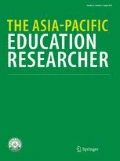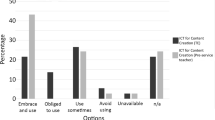Abstract
Prensky (On the Horizon 9:1–6, 2001a, b) and other proponents of the concept of ‘digital natives’ claim that the current generation of undergraduates possesses advanced knowledge and skills in Information Communication Technologies and is highly motivated to learn in this mode. In contrast, there are studies that revealed a variation in the levels of students’ access and a greater tendency to use it for social rather than academic purposes. This suggests that the concept of ‘digital natives’ need further investigation. Studies undertaken on digital natives in Malaysia have generally shown that students are receptive to technology use in learning English; however, no study has clearly delineated the characteristics of Malaysian ‘digital natives’. Thus, the present study intends to fill this gap in knowledge by exploring Malaysian ‘digital natives’ usage of technologies in terms of extent of use, perceived usefulness and perceived ease of use and the influence of learning styles on this usage by juxtaposing the Technology Acceptance Model with Willing’s learning styles construct. A questionnaire survey was used to collect data which were analysed quantitatively. The findings support those of other studies undertaken in other countries. The students only used common technological tools such as emails and Facebook and generally had positive perceptions of the usefulness and ease of use of technology in the learning of English, regardless of learning styles. Although students expressed interest in using more technology, they were using less technology than anticipated in their learning of English and showed a preference for teacher-centred learning.

Similar content being viewed by others
References
Al-Hawari, M. A., & Mouakket, S. (2010). The influence of technology acceptance model (TAM) factors on students’ e-satisfaction and e-retention within the context of UAE e-learning. Education, Business and Society: Contemporary Middle Eastern Issues, 3(4), 299–314.
Bakar, N. A., Latif, H., & Ya’acob, A. (2010). ESL students’ feedback on the use of blogs for language learning. 3L: Language, Linguistics, Literature, 16(1), 120–141.
Bingimlas, K. A. (2009). Barriers to the successful integration of ICT in teaching and learning environments: A review of the literature. EURASIA Journal of Mathematics, Science and Technology Education, 5(3), 235–245.
Chen, P. S. D., Lambert, A. D., & Guidry, K. R. (2010). Engaging online learners: The impact of web-based learning technology on college student engagement. Computers and Education, 54(2010), 1222–1232. doi:10.1016/j.compedu.2009.11.008.
Conole, G. (2008). Listening to the learner voice: The ever-changing landscape of technology use for language students. ReCALL Journal, 20(2), 124–140. doi:10.1017/S0958344008000220.
Corrin, L., Lockyer, L., & Bennett, S. (2010). Technological diversity: An investigation of students’ technology use in everyday life and academic study. Learning, Media and Technology, 35(4), 387–401.
Fishbein, M., & Ajzen, I. (1975). Belief, attitude, intention and behavior: An introduction to theory and research. Reading, MA: Addison-Wesley.
Gu, X., Zhu, Y., & Guo, X. (2013). Meeting the “digital natives”: Understanding the acceptance of technology in classrooms. Educational Technology and Society, 16(1), 392–402.
Hamat, A., Embi, M. A., & Hassan, H. A. (2012). The use of social networking sites among Malaysian university students. International Education Studies, 5(3), 56–66.
Hew, K., & Brush, T. (2007). Integrating technology into K-12 teaching and learning: Current knowledge gaps and recommendations for future research. Educational Technology Research and Development, 55(3), 223–252.
Johnson, G. M. (2006). College student psycho-educational functioning and satisfaction with online study groups. Educational Psychology, 26(5), 677–688.
Johnson, G. M. (2008). Cognitive processing differences between frequent and infrequent internet users. Computers in Human Behavior, 24(5), 2094–2106. doi:10.1016/j.chb.2007.10.001.
Kennedy, G., Judd, T. S., Churchward, A., & Gray, K. (2008). First year students’ experiences with technology: Are they really digital natives? Australasian Journal of Educational Technology, 24(1), 108–122.
Kolb, D. (1976). Learning style inventory. Boston: McBer.
Kolikant, Y. B. D. (2010). Digital natives, better learners? Students’ beliefs about how the Internet influenced their ability to learn. Computers in Human Behavior, 26(6), 1384–1391. doi:10.1016/j.chb.2010.04.012.
Kvavik, R. B. (2005). Convenience, communications, and control: How students use technology. In D. G. Oblinger & J. L. Oblinger (Eds.), Educating the net generation (pp. 7.1–7.20): EDUCAUSE. http://www.educause.edu/educatingthenetgen. Accessed 7 April 2013.
Kvavik, R. B., & Caruso, J. B. (2005). ECAR study of students and information technology 2005: Convenience, connection, control, and learning. CO: EDUCAUSE Center for Applied Research. http://net.educause.edu/ir/library/pdf/ers0506/rs/ERS0506w.pdf. Accessed 2 April 2013.
Liu, M., & Reed, W. M. (1995). The effect of hypermedia assisted instruction on second-language learning through a sematic-network-based approach. Journal of Educational Computing Research, 12(2), 159–175.
Lockley, T. (2013). Answers to outstanding questions about Japanese student ICT competencies and a glance into a mobile future. The Asia-Pacific Education Researcher,. doi:10.1007/s40299-013-0063-3.
Margaryan, A., Littlejohn, A., & Vojt, G. (2011). Are digital natives a myth or reality? University students’ use of digital technologies. Computers and Education, 56(2), 429–440. doi:10.1016/j.compedu.2010.09.004.
Mohd Jaafar, N., & Thang, S. M. (2013). Revisiting autonomy and attributions: A case in a Malaysian university. GEMA Online Journal of Language Studies, 13(2), 41–64.
Oblinger, D. G., & Oblinger, J. L. (Eds.). (2005). Educating the Net generation. EDUCAUSE. http://www.educause.edu/educatingthenetgen. Accessed 7 April 2013.
Oliver, B., & Goerke, V. (2007). Australian undergraduates’ use and ownership of emerging technologies: Implications and opportunities for creating engaging learning experiences for the net generation. Australasian Journal of Educational Technology, 23(2), 171–186.
Pramela, K., Hussin, S., & Sivapuniam, N. (2011). Language learning and language acquisition in online forums. 3L: The Southeast Asian Journal of English Language Studies, 17(2), 91–100.
Prensky, M. (2001a). Digital natives, digital immigrants Part 1. On the Horizon, 9(5), 1–6.
Prensky, M. (2001b). Digital natives, digital immigrants Part 2. Do they really think differently? On the Horizon, 9(6), 1–6.
Rushkoff, D. (2006). Screenagers: Lessons in chaos from digital kids. Cresskill, NJ: Hampton Press.
Saeed, N., Yang, Y., & Sinnappan, S. (2009). Emerging web technologies in higher education: A case of incorporating blogs, podcasts and social bookmarks in a web programming course based on students’ learning styles and technology preferences. Educational Technology and Society, 12(4), 98–109.
Skehan, P. (1998). A cognitive approach to language learning. Oxford: Oxford University Press.
Steel, C. H., & Levy, M. (2013). Language students and their technologies: Charting the evolution 2006–2011. ReCALL, 25(3), 306–320. doi:10.1017/S0958344013000128.
Tapscott, D. (1998). Growing up digital: The rise of the net generation. New York: McGraw-Hill.
Thang, S. M. (2003). Investigating Malaysian distance learners’ conceptions of their learning styles in learning English. GEMA: Online Journal of Language Studies, 3(1), 1–13.
Thang, S. M. (2012). A critical view of Malaysian ESL undergraduates’ readiness for autonomy and its implication for Malaysian education curriculum. In Y. L. Koo & H. Azman (Eds.), Language and literacy in multilingual contexts: Issues and challenges (pp. 157–172). Bangi: Penerbit Universiti Kebangsaan Malaysia.
Thang, S. M., & Alias, A. (2007). Investigating readiness for autonomy: A comparison of Malaysian undergraduates of three public universities. Reflections of ELT Journal, 7(1), 1–18.
Thang, S. M., & Bidmeshki, L. (2010). Investigating the perceptions of UKM undergraduates towards an English for Science and Technology online course. Computer Assisted Language Learning Journal, 23(1), 1–20.
Thang, S. M., Lee, Y. S., & Zulkifli, N. F. (2012a). The role of the electronic portfolio in enhancing information and communication technology and English language skills: The voices of six Malaysian undergraduates. Computer Assisted Language Learning, 25(3), 277–293.
Thang, S. M., Mahmud, N., & Razak, N. A. (2012b). The use of wireless technology in UKM: Challenges faced and its impact on English language learning. 3L: The Southeast Asian Journal of English Language Studies, 18(1), 129–143.
Thang, S. M., Murugaiah, P., Lee, K. W., Azman, H., Tan, L. Y., & Lee, Y. S. (2010). Grappling with technology: A case of supporting Malaysian Smart school teachers’ professional development. Australasian Journal of Educational Technology, 26(3), 400–416.
Thang, S. M., Nambiar, R. M. K., Mohd Noor, N., Mustaffa, R., Mahmud, N., & Ismail, K. (2012c). Using a blended approach to teach English for academic purposes: Malaysian students’ perceptions of redesigned course materials. International Journal of Pedagogies and Learning, 7(2), 142–153.
Thinyane, H. (2010). Are digital natives a world-wide phenomenon? An investigation into South African first year students’ use and experience with technology. Computers and Education, 55(1), 406–414. doi:10.1016/j.compedu.2010.02.005.
Wang, J., Lin, C. C., Yu, W. W., & Wu, E. (2013). Meaningful engagement in Facebook learning environments: Merging social and academic lives. Turkish Online Journal of Distance Education, 14(1), 302–322.
Willing, K. (1988). Learning styles in adult migrant education (1st ed.). Adelaide: National Centre for English Language Teaching and Research, Macquarie University.
Witkin, H. A., & Goodenough, D. R. (1981). Cognitive styles: Essence and origins. New York: International University Press.
Young, M. R., Klemz, B. R., & William Murphy, J. (2003). Enhancing learning outcomes: The effects of instructional technology, learning styles, instructional methods, and student behavior. Journal of Marketing Education, 25(2), 130–142. doi:10.1177/0273475303254004.
Acknowledgments
This work was supported by a research Grant provided by Universiti Kebangsaan Malaysia (UKM-DLP-2012-032).
Author information
Authors and Affiliations
Corresponding author
Electronic supplementary material
Below is the link to the electronic supplementary material.
Rights and permissions
About this article
Cite this article
Thang, S.M., Nambiar, R.M.K., Wong, F.F. et al. A Clamour for More Technology in Universities: What Does an Investigation into the ICT Use and Learning Styles of Malaysian ‘Digital Natives’ Tell Us?. Asia-Pacific Edu Res 24, 353–361 (2015). https://doi.org/10.1007/s40299-014-0185-2
Published:
Issue Date:
DOI: https://doi.org/10.1007/s40299-014-0185-2




